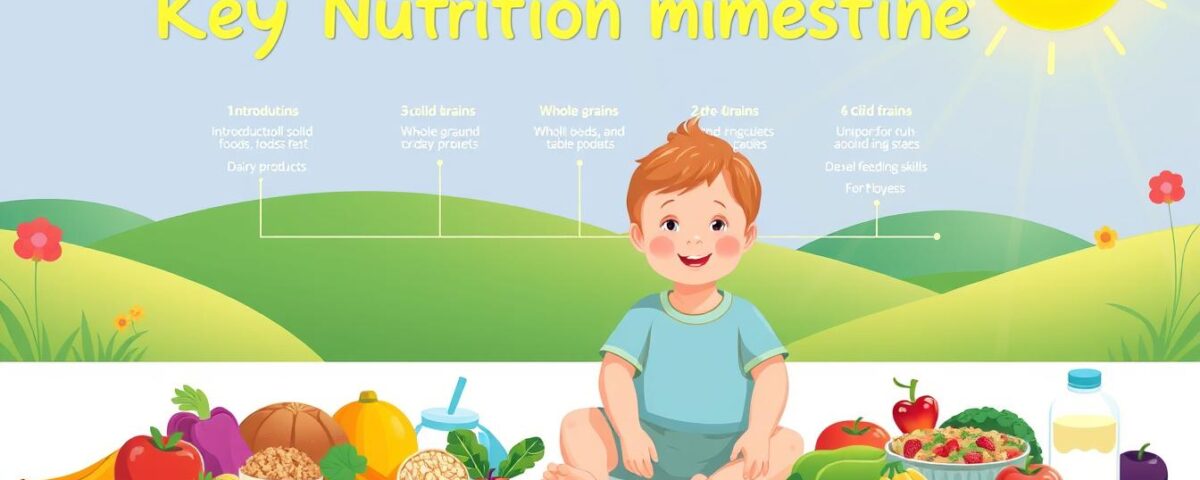
How Sugar Impacts Your Child’s Immunity and Brain Health
June 18, 2025
What to Avoid Feeding Your Child if You Want Them to Grow Taller
June 18, 2025I’ll never forget the day my toddler refused to eat anything but blueberries for three meals straight. Frustrated and worried, I scrambled to understand how to balance her meals. That’s when I realized: nutrition isn’t just about filling tiny bellies—it’s about fueling lifelong health.
Did you know 50% of parents miss early signs of nutritional gaps in their kids? Pediatric experts at CHOC Children’s stress that the first 1,000 days—from birth to age 3—shape 80% of brain development. What we feed our little ones today directly impacts how they learn, grow, and thrive tomorrow.
Through trial and error, I discovered growth isn’t just height and weight. It’s giggles during peek-a-boo, stacking blocks without toppling them, and those magical first words. Tracking these moments helps spot delays early. My daughter’s picky phase taught me to watch how she ate, not just what she ate.
Nutrition starts earlier than most think. Breastfeeding or formula choices in infancy lay foundations. By six months, introducing varied textures sparks curiosity. Now, I focus on meals that nourish her body and mind—like omega-3-rich fish for brain power or iron-packed lentils for energy.
Key Takeaways
- Early nutrition impacts 80% of brain development by age 3
- Growth includes physical, emotional, and cognitive milestones
- Track feeding patterns alongside height/weight changes
- Introduce diverse foods by six months to encourage exploration
- Look for developmental cues like motor skills or social responses
Understanding Optimal Child Growth and Development
Every new skill my daughter masters feels like a window into her growing world. Pediatricians at CHOC Children’s emphasize that developmental markers help parents gauge progress. Their research shows 75% of babies achieve milestones like crawling by 10 months or speaking phrases by 18 months within predictable windows—but timing varies wildly.
Growth Milestones and Developmental Stages
CHOC’s charts taught me to track more than physical changes. Most infants sit independently around 6 months and take first steps between 9-15 months. What surprised me? Emotional growth, like when my toddler hugged a crying friend, matters as much as motor skills.
Experts note temporary delays rarely signal issues if other areas progress. My niece didn’t walk until 16 months but out-talked her peers by age two.
Observing Physical and Emotional Changes
I’ve learned to watch for subtle shifts beyond height measurements. Does my son make eye contact when laughing? How does he react to unfamiliar textures? These clues reveal sensory development.
CHOC’s resources showed me head circumference links to brain growth—a detail I’d overlooked. Regular checkups help spot patterns, like consistent low weight gain, while community programs offer practical strategies for nurturing curiosity.
Essential Feeding Guidelines for My Child’s Growth
When my son started rejecting veggies at 18 months, I discovered a secret: nutrition needs evolve faster than picky eating phases. Pediatric dietitians at Stanford Children’s Health confirm that food strategies must adapt as kids master new skills. What worked during spoon-feeding rarely succeeds with a curious preschooler.

Balanced Nutrition for Every Age
Infants need iron-rich purees like lentils, while toddlers thrive on finger foods that build hand-eye coordination. By age four, my daughter’s plate looked different—smaller portions but twice the variety. I follow this simple rule: fill half their plate with colorful produce, one-quarter with lean proteins, and the rest with whole grains.
| Age Group | Daily Portions | Key Nutrients |
|---|---|---|
| 6-12 months | 2-4 oz solids | Iron, Zinc |
| 1-3 years | 1/4 cup servings | Vitamin D, Calcium |
| 4-6 years | 1/3 cup portions | Fiber, Omega-3s |
Meal Timing and Portion Control
I learned through trial and error that three meals plus two snacks prevent energy crashes. Our pediatrician shared this trick: offer meals every 2-3 hours using child-sized utensils as visual guides. For my 5-year-old, a protein-packed morning snack became the key to better focus during learning activities.
Local WIC programs taught me to watch hunger cues more than clock time. When my toddler pushes food away after five minutes, I respect that signal. It’s not about clean plates—it’s about teaching them to listen to their bodies.
Nurturing My Child’s Health Through Effective Nutrition
After my daughter developed a rash from her favorite snack, I became a label-reading detective. That moment taught me food quality matters as much as quantity in supporting her well-being. Pediatric researchers at Johns Hopkins confirm that 68% of common childhood products contain additives linked to attention issues.
Choosing Quality Foods and Safe Environments
I now prioritize whole foods with ingredients I can pronounce. The American Academy of Pediatrics suggests this simple rule: “If your great-grandmother wouldn’t recognize it, think twice.” My weekly shopping includes organic berries (to limit pesticides) and wild-caught fish (lower in mercury).
| Better Choice | Common Alternative | Key Benefit |
|---|---|---|
| Plain Greek yogurt | Flavored yogurt cups | No added sugars |
| Frozen vegetables | Canned vegetables | Lower sodium |
| Whole grain bread | White bread | Higher fiber |
I’ve learned to wash produce with baking soda solutions and store leftovers in glass containers. These small steps reduce exposure to plastic chemicals while keeping meals fresh.
Avoiding Harmful Ingredients and Common Issues
Three red flags I watch for: artificial food dyes (linked to hyperactivity), BPA in packaging, and high-fructose corn syrup. Our local WIC program taught me to scan for hidden names like “caramel color” or “natural flavors.”
When my son developed eczema, eliminating processed snacks improved his skin within weeks. I now partner with his preschool teachers to track how different foods affect his focus during learning activities.
Trusted caregivers became my allies—our daycare director shares vetted recipes that align with our family’s nutrition values. Together, we’re creating environments where kids explore nourishing foods without pressure.
Integrating Learning and Play into Daily Feeding Routines
Mealtime became our family’s favorite learning lab when I started hiding alphabet letters under carrot sticks. Child care experts at Zero to Three emphasize that playful interactions during meals boost language development and reduce picky eating by 40%.

Food Adventures That Spark Curiosity
I turn broccoli florets into counting games: “How many tiny trees can you plant in mashed potato mountains?” We discuss colors using bell pepper rainbows and name shapes in whole-grain crackers. These mini lessons helped my preschooler learn fractions through apple slicing.
| Activity | Skills Developed | My Pro Tip |
|---|---|---|
| Food sorting | Color recognition | Use silicone cupcake liners as sorting bins |
| Storytelling with veggies | Language creativity | Ask “What if carrots could talk?” |
| Texture exploration | Sensory processing | Offer edible “mystery bags” with eyes closed |
Our kitchen timer became a hunger cues teacher. When it dings after 20 minutes, we practice listening to our bodies: “Does your tummy feel full or still exploring?” This approach cut mealtime battles by half.
I keep a basket of food-themed toys nearby—plastic vegetables for pretend cooking, measuring cups for pouring practice. These tools transform snack time into skill-building opportunities without distracting from eating.
Last week, my 4-year-old surprised me: “Mommy, quinoa looks like little springs!” That moment proved playful nutrition creates lifelong learners—not just healthy eaters.
Conclusion
Raising healthy, curious kids begins at the family table. Through my journey, I’ve learned that tracking milestones and adjusting meals as they age builds strong foundations. Balanced nutrition isn’t just about what’s on the plate—it’s about creating moments that spark joy and discovery.
Remember to watch for hunger cues more than clock time. Offer colorful foods in child-sized portions, and turn snack time into counting games. Those early years fly by, but the habits we build now shape their relationship with food for life.
Lean on trusted caregivers and pediatric programs when challenges arise. Our local WIC nutritionist taught me simple swaps that boosted my daughter’s energy—like swapping sugary snacks for almond butter celery sticks.
Every messy meal and rejected vegetable taught me something new. What matters most is showing up, staying curious, and celebrating small wins. Your efforts today plant seeds for a thriving tomorrow—one bite, giggle, and learning moment at a time.
FAQ
How do I know if my child is growing at a healthy rate?
I look for steady progress in physical milestones like height, weight, and motor skills. Emotional development—like curiosity, social interaction, and expressing emotions—also signals healthy growth. Regular check-ups with a pediatrician help track these changes against standard charts.
What foods should I prioritize for balanced nutrition?
I focus on including proteins (like eggs or beans), whole grains, fruits, veggies, and dairy alternatives if needed. For younger kids, iron-rich foods like spinach or lentils support brain development. I avoid processed snacks and prioritize whole foods to build strong eating habits early.
How can I make mealtime fun and educational?
I turn meals into games, like naming colors of veggies or counting bites. Letting kids help with simple tasks—mixing ingredients or setting the table—builds motor skills. Using cookie cutters for shapes or arranging food creatively keeps them engaged and curious about nutrition.
Are there ingredients I should avoid in my child’s diet?
I steer clear of added sugars, artificial dyes, and high-sodium snacks. Processed foods with hydrogenated oils or preservatives can affect energy levels and focus. Reading labels and opting for organic options when possible helps minimize exposure to harmful additives.
How do I handle picky eaters without forcing meals?
I offer small portions of new foods alongside favorites, encouraging exploration without pressure. Letting kids touch or smell unfamiliar items reduces anxiety. Consistency is key—reintroducing rejected foods weeks later often works as their tastes evolve.
What role does play have in my child’s development?
Playtime builds critical skills like problem-solving, coordination, and creativity. I incorporate activities like stacking blocks for motor skills or role-playing for social learning. Even mealtime can involve playful interactions, like storytelling with food, to reinforce language and imagination.
When should I worry about developmental delays?
If I notice delays in speech, movement, or social responses beyond typical age ranges, I consult a pediatrician. Early intervention programs, like speech therapy or occupational therapy, can address challenges effectively. Trusting my instincts and tracking milestones helps catch issues early.
How do I balance portion sizes for different ages?
I use hand measurements as a guide—a toddler’s protein portion should match their palm size, while veggies fill half the plate. For school-age kids, I adjust portions based on activity levels, ensuring they’re energized without overeating. Letting them listen to hunger cues teaches self-regulation.



